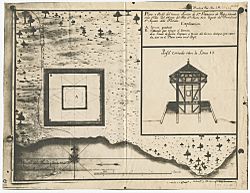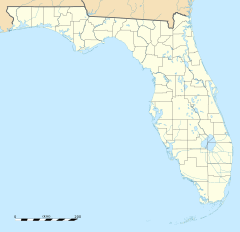Fort San Francisco de Pupo facts for kids
Quick facts for kids Fort San Francisco de Pupo |
|
|---|---|
| Northwest of St. Augustine, Florida, on west bank of the St. Johns River in United States | |

Plan and Profile of Fort San Francisco de Pupo
|
|
|
Location of Fort San Francisco de Pupo
|
|
| Coordinates | 29°56′19″N 81°36′14″W / 29.93861°N 81.60389°W |
| Height | 32 ft. |
| Site information | |
| Condition | Only traces remain |
| Site history | |
| Built | 1734 |
| Built by | Spanish Army (Ejército de Tierra) |
| In use | 1740 |
| Materials | Pine log palisade and blockhouse |
| Events | Seized by James Oglethorpe's troops |
| Garrison information | |
| Past commanders |
British Captains MacKay and Desbrissy |
| Garrison | Regular army troops |
Fort San Francisco de Pupo was an old Spanish fort built in the 1700s. It was located on the west side of the St. Johns River in Florida. This spot was about 18 miles from St. Augustine, which was the main city of Spanish Florida at the time.
Fort Pupo was very important because it sat on an old trail called El Camino Real. This trail led to a Spanish area called Apalachee in western Florida. Fort Pupo and its partner fort, Fort Picolata, on the other side of the river, controlled all the people and goods crossing the river by ferry.
Today, you can still find traces of Fort Pupo about three miles south of Green Cove Springs in Clay County. The area around it is a forest with large trees like southern live oak, southern magnolia, and pignut hickory.
In the 1950s, a team led by John Goggin from the University of Florida dug up the site. They found that the first Fort Pupo was very small, like a simple guard shack. A Spanish engineer described it as "a sentry box built of boards, eight feet in diameter… surrounded by a palisade." In 1738, a new, stronger fort was built. It included a wooden blockhouse (a small fort), barracks (places for soldiers to sleep), and storage buildings.
History
Building the Fort
For many years, there was a lot of tension between the Spanish in Florida and the British in the nearby colony of Carolina. The British governor, James Moore, had even attacked Florida in 1704 and 1706. Because of these worries, the Spanish governor, Francisco del Moral y Sánchez, ordered Fort Pupo to be built in 1734. It was meant to protect against more attacks from the British and their Native American allies.
Attacks and Changes
In 1738, a group of Yuchi Native Americans, who were allies of the British, attacked Fort Pupo. They damaged the fort's walls and killed two soldiers. After this attack, the Spanish made the fort bigger and stronger. They built a 30-by-16-foot blockhouse and surrounded it with a timber and earth wall. A small group of ten soldiers, a sergeant, and seven cannons were stationed there to defend it.
Around the same time, James Oglethorpe, the governor of the British colony of Georgia, started gathering his forces. He planned to invade Florida.
Oglethorpe's Invasion
A war called the War of Jenkins' Ear broke out between Spain and Britain. The Spanish had attacked a British outpost and hurt some soldiers. In response, Oglethorpe decided to attack the Spanish forts that protected St. Augustine. He gathered a large force of soldiers and Native American allies, including Highland Rangers, soldiers from the 42nd Regiment of Foot, and Creek, Chickasaw, and Yuchi warriors.
In late 1739, Oglethorpe began his invasion. His goal was to bother the Spanish, burn their farms, and scare their Native American allies. On January 6, 1740, his raiding party left a fort he had built at the mouth of the St. Johns River, Fort Saint George. They were joined by an armed English privateer ship.
Capturing the Forts
Oglethorpe led his forces up the St. Johns River to attack Forts Picolata and Pupo. They landed five miles downstream on the east side of the river. They marched quietly at night and reached Fort Picolata at 2:00 a.m. on January 7. A group of Highlanders and Native Americans led the attack. By morning, they had captured and burned Fort Picolata.
From the other side of the river, the Spanish soldiers at Fort Pupo saw Oglethorpe's Native American allies. They thought they were friendly Native Americans and sent a ferry across the river. But when the ferry crew realized their mistake, they quickly turned back.
Oglethorpe then landed his main soldiers a mile north of Fort Pupo. They marched towards the fort with four cannons. A group of Native Americans and Rangers attacked the fort first. Then, soldiers under Ensign Sanford Mace began firing their cannons. The combined attack forced the Spanish defenders to give up just before sunset. The Highlanders and Native American scouts took control of the fort and captured the Spanish soldiers.
Oglethorpe left 50 Highlanders, led by Captain Hugh MacKay, Jr., to guard Fort Pupo. He also left them the ship. Then, he returned to Fort Frederica. Oglethorpe had successfully attacked and captured Forts Pupo, Picolata, and San Diego during these early raids. He hoped these attacks would help his bigger plan to capture St. Augustine by land and sea. However, these raids turned out to be the only successes in his attempt to take the city in 1740.



